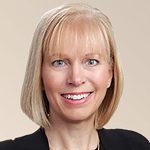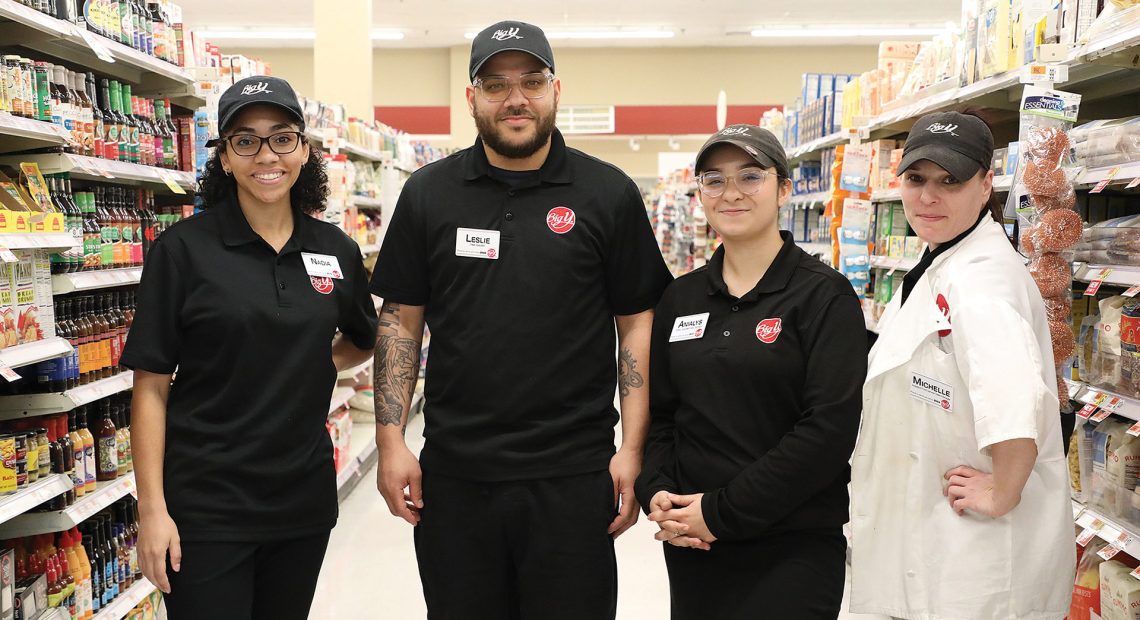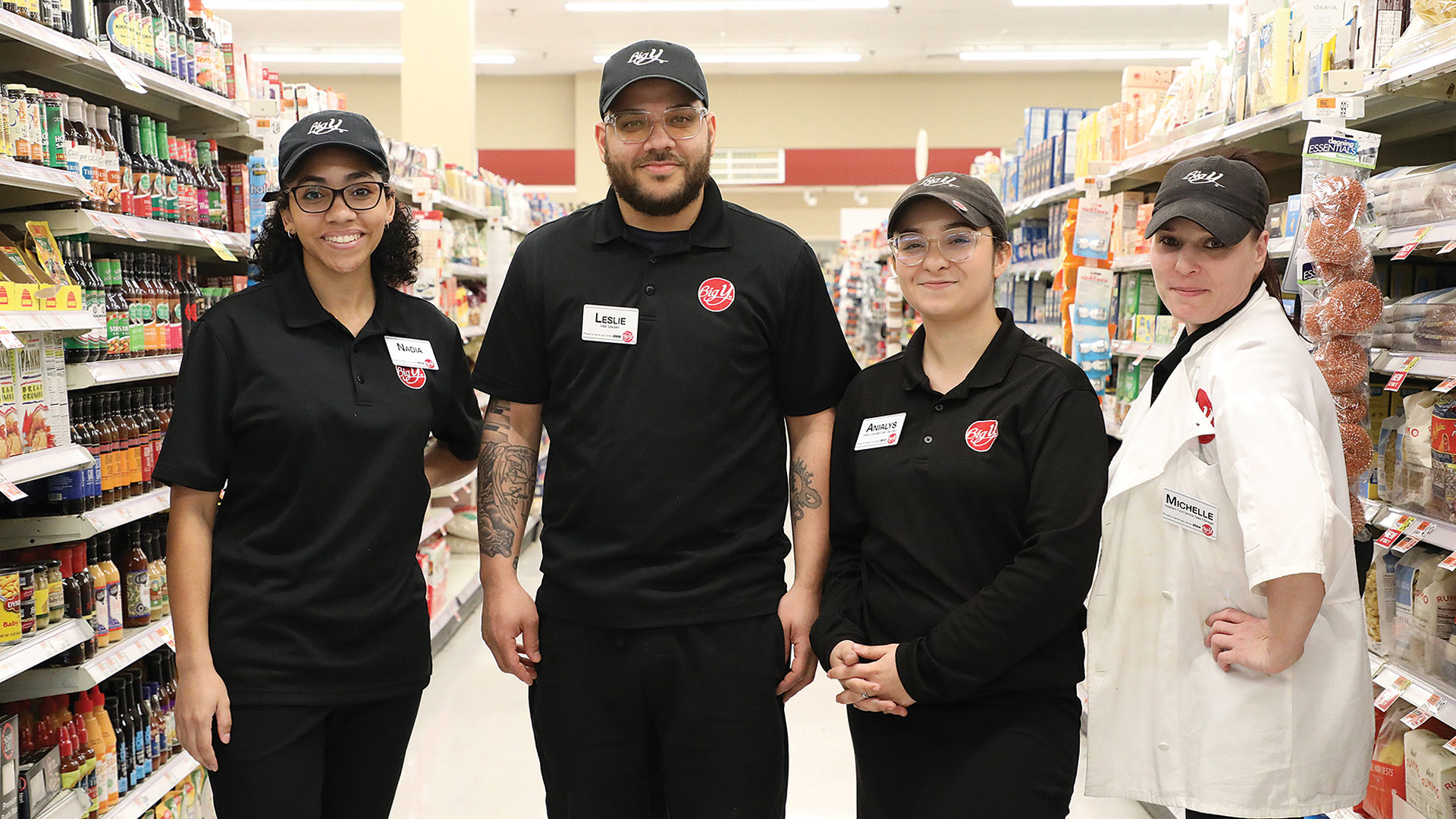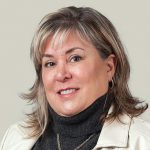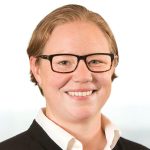Putting a Premium on Measured Growth
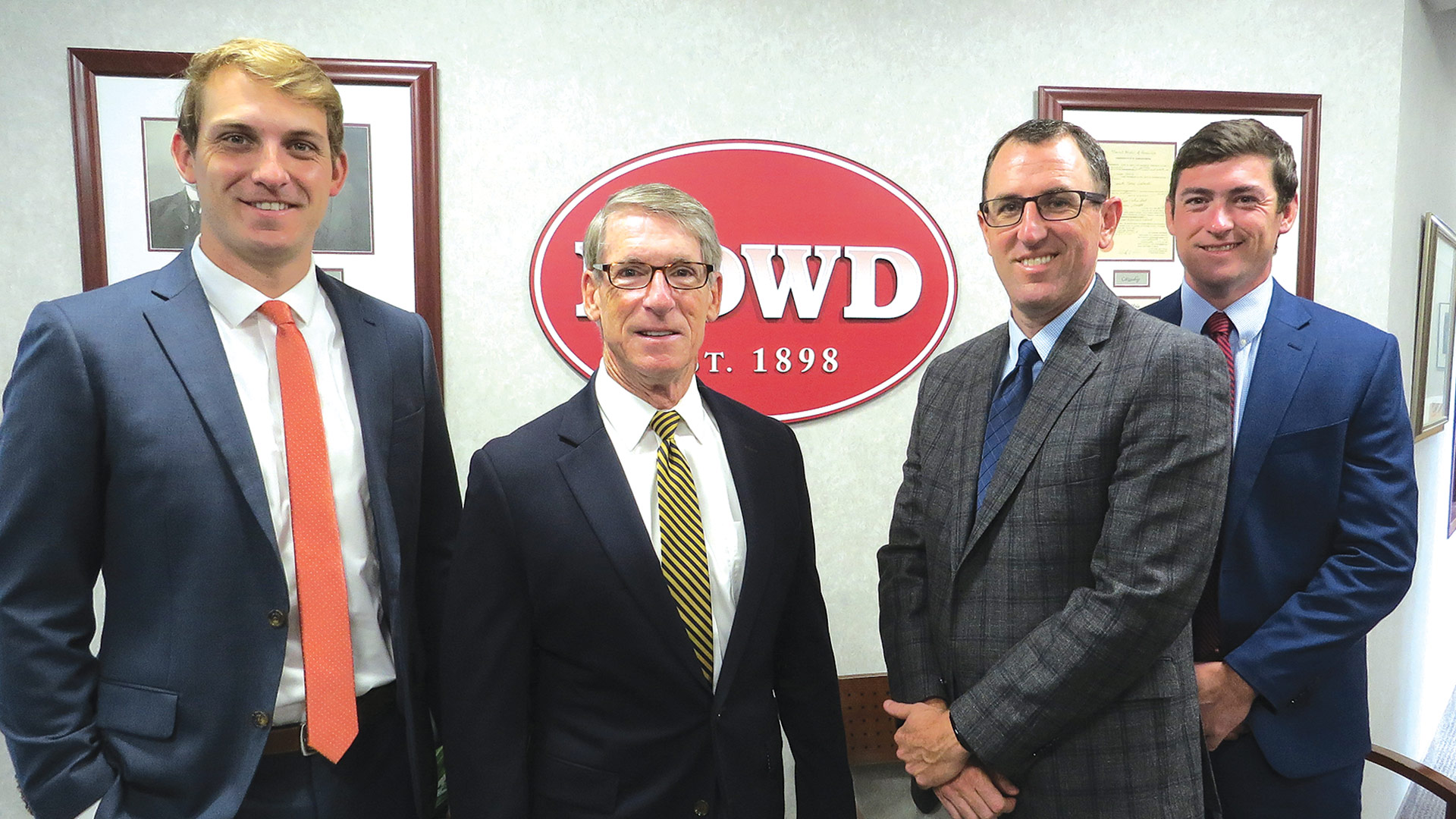
Current and future leaders at the Dowd Agencies, from left: Evan Dowd, account executive; John Dowd Jr., president and CEO; Dave Griffin Jr., senior vice president; and Jack Dowd, vice president of Personal Lines.
There’s a framed picture of downtown Holyoke on one wall of the conference room at the Dowd Agencies — downtown Holyoke circa 1870.
The view is looking west along Dwight Street by the first-level canal. City Hall, prominent in the upper-left corner, looks … exactly as it does today. The other side of Dwight Street, not so much — most of the buildings seen in the image have been gone for decades. For perspective, a horse-drawn carriage is moving east down the hill.
John Dowd Jr. said the picture was owned by a long-time client who offered it to him after Dowd repeatedly raved about it. He accepted the offer and gave the picture a prominent home — across the conference room from another framed photo, this one of the insurance company’s founder, James J. Dowd, who went into business just a few decades after that picture of downtown was taken.
Together, the pictures provide some needed perspective — about time, Holyoke, the company, change, what hasn’t changed — and how they all come together. And the juxtaposition of all this will come into even sharper focus in 2023, when the agency, which Dowd claims is the oldest family-owned insurance agency doing business in the Bay State, celebrates its 125th birthday.
“We want to continue to grow, but want to make sure we’re not growing too quickly; we don’t want to get over our skis, as we like to say.”
There hasn’t been much hard planning about how to mark that milestone, he said, adding that he and others will pick up the pace in the coming months and put together some events and programs, as they did for the company’s centennial in 1998.
“We have a few things we’re planning that are in the works,” he said. “We’re trying to do some things that involve the community; overall, it’s an opportunity for us to say ‘thank you’ to the community for supporting us for 125 years and through five generations. That’s an important ‘thank you,’ and we’re thinking long and hard about what we’re going to do.”
In the meantime, the company is taking steps to ensure that it can continue its long history as an independent agency, said Dowd, noting, for example, the latest in a series of recent acquisitions that provide needed size and flexibility at a time of continued consolidation in the insurance industry.
Just last month, the firm acquired the Ideal Insurance Agency in Ludlow, which, like many smaller, family-owned agencies in the area, became available for one of many reasons, ranging from COVID-19 to lack of a clear succession plan to the inability to effectively compete in a market increasingly dominated by larger firms.

This photo of downtown Holyoke, circa 1870, has earned a spot on the wall in the conference room at the Dowd Agencies.
This was the third such acquisition over the past two years, coming after Dowd bought the J. Raymond Lussier agency in West Springfield and the Wilcox agency in Westfield and Feeding Hills. This expansion has given the agency much greater size, and in insurance, as in banking and most all other sectors, size matters, and it bring benefits.
“The advantages come with volume with carriers,” Dowd explained, noting that the firm is roughly 30% larger than it was a few years ago, and almost double the size it was a decade ago. “The more volume you have, the better compensation you negotiate, as well as profit sharing, services, and other perks. We’ve been able to achieve some of that volume leverage through aggregation with other agencies and through M&A.”
Moving forward, the agency will continue to look for opportunities for growth organically, and also through additional acquisitions, said Dowd, adding that it approaches this assignment with an eye toward smart growth and not taking on too much too quickly.
“We want to continue to grow, but want to make sure we’re not growing too quickly; we don’t want to get over our skis, as we like to say,” he noted, borrowing a phrase used often in business to connote getting ahead of oneself with a specific strategic initiative. “A healthy company grows organically and also through M&A. With the M&A, it has to be measured growth, but organic growth is essential — that’s boots on the ground, bringing in new clients, retaining your current clients; that’s good, healthy growth, augmented by acquisition, which comes with debt, which obviously has to measured and balanced.”
Meanwhile, there are other matters to consider, said Dowd, including succession planning for this agency, something that is obviously taken seriously at a company that has been around this long, covets its independence, and wants things to stay that way.
For this issue and its focus on insurance, BusinessWest talked with Dowd about … well, everything conveyed by those two photos in the conference room.
Cover Story
Dowd told BusinessWest that the phone calls come maybe once a week, or five or six times a month on average.
They’re from representatives of private-equity firms who want to know if Dowd Insurance might be for sale, and, if so, under what circumstances. He tells them ‘no,’ and in a polite way — at least the first time they inquire.
“I’ll usually have one conversation with them and let them know that we’re not interested in selling and are happy to stay the way we are. And then when they call the next month with the same question, my patience starts to wane, and I start to wonder about how obligated I am to answer every email and every phone call, especially when I’ve already talked to them and told them my plan.”
“They are relentless,” said Dowd of those on the other end of the phone. “I’ll usually have one conversation with them and let them know that we’re not interested in selling and are happy to stay the way we are. And then when they call the next month with the same question, my patience starts to wane, and I start to wonder about how obligated I am to answer every email and every phone call, especially when I’ve already talked to them and told them my plan.”
These days, there are even more people calling and asking about the agency, he noted, and that’s because of those acquisitions over the past few years and the scale they generate.
It’s a somewhat minor annoyance, and at the same time a reminder of the agency’s track record for success, he said, adding, again, that he is polite, but only to a point.
Dowd has other matters to occupy his time, he noted, adding that, overall, the firm is still trying to make its way all the way back to where it was before the start of the pandemic, especially with “behind-the-scenes” work, as he called it, when it comes to quality, efficiency, and serving clients.
“We have a quality team that evaluates what we do and how we do it,” he explained. “They would get suggestions every month from anyone on the staff — ‘here’s an area that I think we can look at and get better at’ — and the quality team would research and come to us with suggestions for developing a plan. That’s an example of an area where we lost some momentum.”
Some momentum was also lost when it came to connecting with potential new customers, he went on, adding that this put far greater emphasis on growth through acquisition, which is exactly what the company did.
“From a revenue standpoint, we were flatlining — if we held onto everything,” he explained. “And we didn’t hang onto everything because businesses were closing. It was a scary time because there was so much uncertainty. But then came the M&A opportunity, and we looked at it and said, ‘this is not a great time to be taking on some debt, but we think this is prudent.”

John Dowd Jr., seen here next to a photo of the company’s founder, James J. Dowd, says the Dowd Agencies targets controlled, ‘smart’ growth, both organically and through acquisition.
Elaborating, he said the agencies that came into consideration were good fits, culturally and otherwise, and under normal circumstances, they would be consider logical acquisitions. The circumstances weren’t normal, but the times dictated some aggressive action.
“Sometimes you’ve got to stick your chin out there and, when opportunity knocks, take advantage of the opportunity,” he said, adding that this is just what the firm has done.
In doing so, it has put itself in and new different position — an independent agency of considerable size — and it is determined to sell both of those qualities.
“We’re a good-sized agency, certainly in Western Mass., and the only one of our size that is still independently owned — not owned by one of the big guys,” he said. “We like that distinction, and we use it to our advantage. We’re totally local — not only do we live and participate in our community here, we’re also locally owned, and profits go right back here in to Western Mass., and not Chicago or anywhere else.”
But with that independent status comes the challenge to compete with those often much larger concerns, Dowd explained, adding that this challenge, as in banking and other sectors, is very real and becoming more stern with each passing year.
“We’re at a point now where getting to the next level requires a higher level of sophistication in just about every area,” he said. “Obviously, technology is huge because it creates the efficiencies we need. Meanwhile, the labor market is extremely difficult and challenging right now.
“The investment in technology and the way we staff ourselves, the levels of management … all of these important areas have to be looked at and adjusted accordingly,” he went on. “You can’t keep doing things the way you were when you were half the size. You have to be forward-thinking in this business; you have to be looking ahead and be prepared for what may come, and you know the unexpected will happen. You have to be nimble enough to be able to adjust.”
Prudent Policy
As he looks forward, Dowd sees the agency doing what it has been doing all along and especially over the past decade or so — seeking to grow organically, but also looking for opportunities to grow through acquisition and expand geographically.
The agency currently has nine locations, all in Western Mass., but it is exploring options well beyond this area code, he noted.
“We’ve looked at Northern Connecticut, we’ve looked at acquisitions in Vermont and New Hampshire, and we’ve also looked at Eastern Mass., toward Worcester, working our way in that direction,” he said, adding that, while the agency serves clients in those areas and others, including Boston and New Jersey, it does not have a physical presence in those locations, but could attain some if the conditions are right.
“In our business, it’s about where your network of contacts takes you and what your appetite for challenge is,” he told BusinessWest. “Do you want to do what it takes to be regional and available and able to support services? You just have to be realistic that you can do what you say you can do.
“We’re careful and selective with regard to companies where there’s some distance,” he went on. “But we’re looking at some relationships in New York right now where we could possibly have an ofice and be able to operate similarly, but on a smaller scale, to what we’re doing here.”
Overall, there are a number of ways to get to the proverbial next level in terms of size and revenues, he went on, adding that, while remaining independent is the preferred route, the agency will consider all its options. “We’re evaluating what steps we need to take in order to continue to grow and build the company.”
Returning to those phone calls he gets from the private-equity firms, Dowd noted, again, that he doesn’t take many of those calls anymore.
“I feel bad about that, but not too bad,” he explained. “I get a lot of messages — they call and they say they’re from such and such firm, and he’s calling again; I talked to him a year or two ago and told him I’ll call if anything changes.”
Nothing has really changed, at least on that front, he went on, adding that there has certainly been change with regard to the company’s size, reach, and position among area agencies.
Over the course of 124 years, many things have changed, but the most important ingredient hasn’t — this is still an independent, family-owned agency.
And as it prepares to mark another important milestone, that’s a quality worth celebrating.
George O’Brien can be reached at [email protected]






